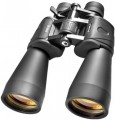Field of view 1 km away
The diameter of the area visible through binoculars / monoculars from a distance of 1 km — in other words, the largest distance between two points at which they can be seen simultaneously from this distance. It is also called "linear field of view". Along with the angular field of view (see below), this parameter characterizes the space covered by the optics; at the same time, it describes the capabilities of a particular model more clearly than data on viewing angles. Models with magnification adjustment (see above) usually indicate the maximum field of view — at the lowest magnification and
the widest angle of view. This information is often supplemented by data on the minimum value.
Min. focus distance
The smallest distance to the observed object, at which it will be clearly visible through binoculars / monoculars. All such optical instruments were initially created for observing remote objects, therefore, not all of them are able to work at short distances. When choosing a model for this parameter, one should proceed from the expected observation conditions: ideally, the minimum focus distance should not be greater than the smallest possible distance to the observed object.
Diopter adjustment
The presence in binoculars / monoculars of the function of diopter correction. This feature will be very useful if you wear glasses due to nearsightedness or farsightedness. By setting the required number of "plus" or "minus" diopters on the adjustment scale, you can look into the eyepiece with the naked eye and see a clear picture — the optics of the device will provide the necessary correction. It is much more convenient than watching through glasses. However one should not forget that the correction range (see below) is usually small, and in case of serious visual impairments, the capabilities of the binoculars may not be enough; but such situations are still quite rare. In binoculars (see "Type"), this adjustment is usually carried out for each eyepiece separately, because The diopters required for each eye may also be different. Features of the correction control depend on the type of focus (see below). With separate focus, each eyepiece is adjusted with its own regulator, with the central one of the halves (usually the left) is regulated using a common focus handwheel, and the second with a separate knob on the eyepiece (although here there are separate regulators on both eyepieces).
Eye relief
The offset is the distance between the eyepiece lens and the exit pupil of an optical instrument (see "Exit Pupil Diameter"). Optimum image quality is achieved when the exit pupil is projected directly into the observer's eye; so from a practical point of view, offset is the distance from the eye to the eyepiece lens that provides the best visibility and does not darken the edges (vignetting). A large offset is especially important if the binoculars / monoculars are planned to be used simultaneously with glasses — because in such cases it is not possible to bring the eyepiece close to the eye.
Nitrogen filled
The presence of a
special gas in the body of binoculars / monoculars — usually nitrogen or argon. Due to its chemical inertness, such a gas does not oxidize internal parts (unlike the oxygen contained in the air). In addition, this function assumes the tightness of the case, which allows most of these binoculars to endure even diving under water (for more details, see "Dust and water protection"), and also protects the optics from the harmful effects of fog. All this has a positive effect on the reliability and service life of the device. In turn, the gas filler itself contains practically no water vapor — thanks to this, the lenses do not fog up from the inside, as happens with conventional models during temperature changes.
Dustproof, water resistant
The body of the binocular / monocular
is protected from dust and moisture. You should pay attention to such models if you plan to use the device in nature — while hiking, hunting, fishing, etc. The degree of such protection can vary, from splash resistance to water immersion; this point should be clarified according to the official characteristics. Also note here that most of the "waterfowl" models usually have gas filling (see above), and the absence of such filling, usually, indicates low moisture resistance.
Tripod adapter
The presence in the design of the binoculars / monocular
socket for attaching an adapter for a tripod(the adapter itself is not included in the kit, unless otherwise indicated). This feature is especially important for high magnification models (see above): they are usually heavy, making it difficult to hold stable in your hands, and at high magnification, even slight shaking can make observation impossible. In addition, mounting on a tripod is convenient for constant observation of a certain place, and such observation does not always require high magnification. Therefore, even fairly small devices can have the possibility of attaching an adapter. The adapters themselves can be designed for different sizes of tripod mounts — this must be taken into account when choosing such a model.

